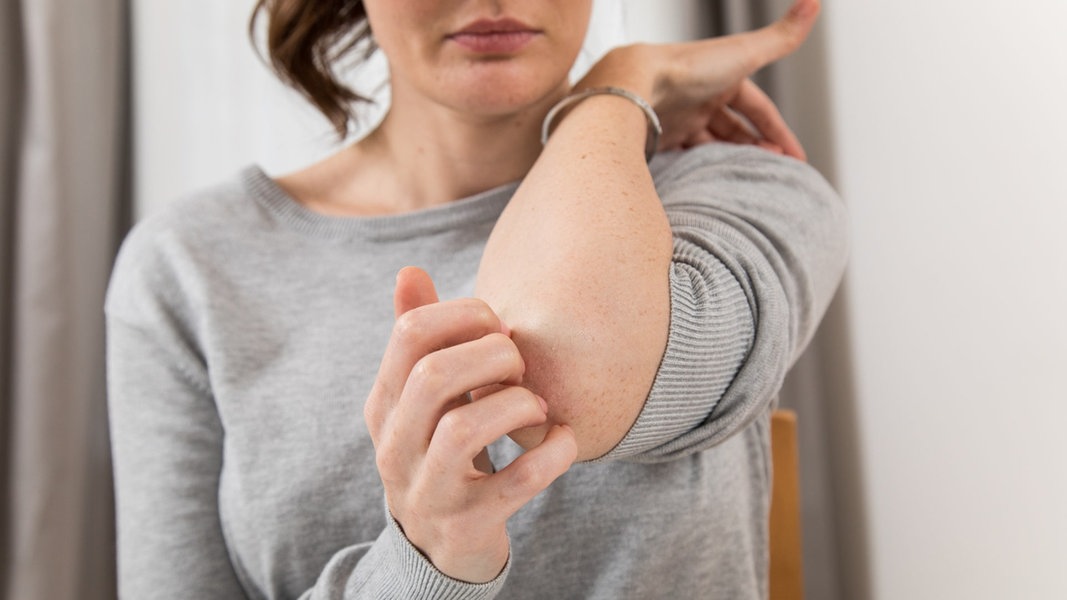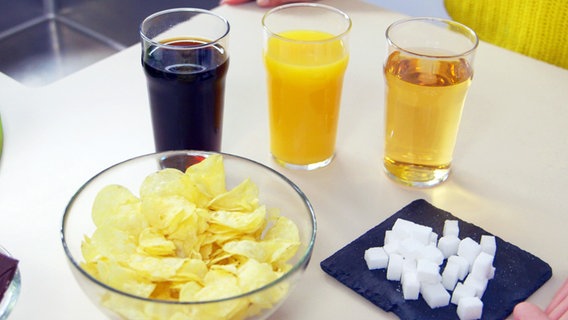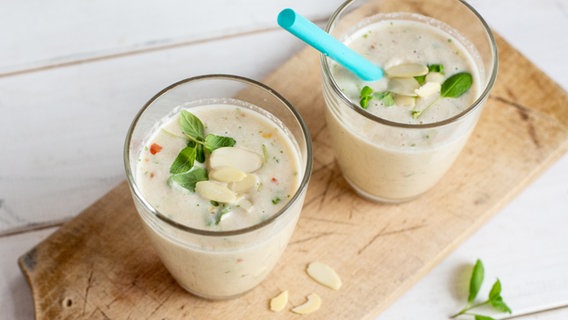Status: 04/24/2023 09:23 a.m
Neurodermatitis is one of the most common skin diseases today. It usually begins in childhood, progresses in phases and often occurs together with food intolerance.
Neurodermatitis, also called atopic eczema, is not contagious. In Germany, 3.5 to 5 million people suffer from the itchy reddened skin – and the trend is rising. The disease is particularly common in infancy and early childhood, with around one in eight preschool children being affected. In most children, symptoms disappear by puberty. Only about three percent of adults suffer from neurodermatitis.
Causes of neurodermatitis
The skin and mucous membranes react overly sensitively to a presumably hereditary disorder of the immune system. The body mistakes harmless substances such as house dust, pollen or certain foods for dangerous foreign bodies and reacts to them with inflammation: it produces an excessive amount of immunoglobulin E (IgE). This activates so-called mast cells in the skin, which release more histamine. They increase the inflammation and cause the characteristic itching. At the same time, they disrupt the skin’s barrier function: it produces too little sebum and too little sweat, and the acid mantle suffers. The dryness of the skin makes it easier for bacteria and viruses to penetrate – and this in turn promotes inflammation.
Triggers lead to flare-ups of neurodermatitis
Certain triggers, also called key stimuli or “triggers”, lead to the onset or worsening of the disease. These include:
- psychological factors (stress, conflicts, boredom)
- environmental factors (pollen, house dust, chemicals)
- Nutrition (certain foods, additives)
- Climatic factors (overheated air, cold, muggy),
- mechanical skin irritations (scratching, too tight, rubbing clothing)
- Animal hair (cat, guinea pig, hamster, horse) and feathers
- infections
Symptoms of neurodermatitis
Atopic dermatitis is expressed by a dry, rough and cracked skin surface that often flakes. There are two stages of the disease: In the acute stage of inflammation, the skin is swollen, deep red, weeping and forms very itchy blisters. In the chronic stage, the skin flakes, has a coarse surface relief (lichenification), is reddened and sometimes swollen. It is also itchy – those affected often scratch themselves bloody. After all, bleeding areas no longer itch because histamine is no longer released there.
The dermatologist will ask about the medical history and family history. Skin and blood tests can be used to find out food intolerance, pollen allergies or other allergies. In the case of pollen allergies, there are often cross-allergies with certain foods.
Medicines for neurodermatitis
For a long time there were hardly any therapies that could really help people with severe neurodermatitis. That changed a few years ago with the introduction of so-called biologics. Experts even speak of a quantum leap, because although these drugs cannot cure neurodermatitis either, the symptoms can be largely eliminated with their help.
Certain messenger substances, so-called interleukins, play a decisive role in the development and maintenance of inflammation and itching. The drug dupilumab has been approved since 2017. The so-called biologic is administered by injection every two weeks and blocks the receptor for the interleukins 4 and 13, which are responsible for the inflammation. This means that the inflammatory mechanisms in the cells can no longer be activated. The inflammatory process collapses, the itching disappears.
Baricitinib, upadacitinib, and abrocitinib reduce inflammation
There is now an alternative for patients who cannot tolerate biologicals such as dupilumab or who do not respond to them: the so-called Janus kinase inhibitors baricitinib, upadacitinib and abrocitinib inhibit the transmission of signals for the inflammation within the cell and thus bring the inflammation to a standstill . They are taken as tablets daily. Since Janus kinase inhibitors can have side effects such as infections of the upper respiratory tract, reactivation of herpes infections, changes in the blood count or increased cholesterol levels, patients have to go to their doctor for regular check-ups.
Patients aged 65 years or older who are at increased risk of serious cardiovascular problems (e.g. myocardial infarction or stroke), smokers and an increased risk of cancer, Janus kinase inhibitors should only be used if no suitable treatment alternatives are available. They should be used with caution in patients with risk factors for blood clots in the lungs and deep veins.
The right skin care for neurodermatitis
The skin camera makes the smallest inflammation visible.
In addition to these modern drugs, people with neurodermatitis always need good basic care, for example with glycerin or urea (urea) twice a day, since their skin needs a lot of oil and moisture. In the case of an acute attack, a short-term external therapy with cortisone helps. Anti-itch creams with so-called calcineurin inhibitors can be used on the face, which, unlike cortisone, do not thin the skin.
Treatment varies from case to case
The treatment approaches must be individually tailored to the individual affected. This also applies to nutritional therapy. After all, there are some general rules: A balanced diet strengthens the body against infections, which in turn can trigger flare-ups. Alcohol, coffee, and strong spices can be problematic because they increase blood flow to the skin, which makes itching worse. Also be careful with quickly absorbable sugar – such as in sweets and white flour products – because it generally promotes inflammatory processes in the body. Incidentally, honey and thick juices are not an alternative to ordinary sugar, as studies have shown. Like table sugar, they consist mainly of sucrose. Anti-inflammatory work against it antioxidants.
Those affected should generally only avoid foods to which they are intolerant. Because if you forego too much food out of fear, you will no longer be able to provide your body with all the nutrients it needs in the long run – there is a risk of malnutrition. Keeping a food diary can help you find out which products you react to. After a few days or weeks, logical connections appear: for example alcohol or a lot of white flour at the weekend – and then on Monday the red spots bloom. By the way, food intolerances can be eliminated or newly added in the course of life.
Some foods promote eczema
Certain foods often fuel neurodermatitis – be particularly vigilant here: tomatoes, kiwi, strawberries and sour fruit. Too much fish, egg, nuts, milk, hard cheese or long-life sausage such as salami can also trigger allergic reactions. Likewise colourings, flavorings and preservatives – therefore it is better to buy natural food and cook a lot fresh.
If you want to have a positive influence on the course of the disease, you should definitely focus on regular physical activity and relaxation in addition to diet. Atopic dermatitis mostly affects sensitive people who do not have “thick skin”. It is no coincidence that the saying goes: “The skin is a mirror of the soul”. Yoga or autogenic training, nature walks, music – be mindful of yourself and see what helps you.
experts on the topic
nutritional therapy
To print (PDF)





